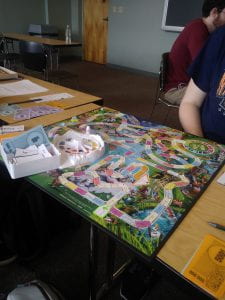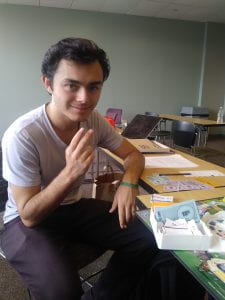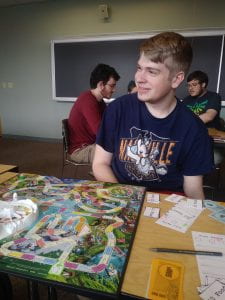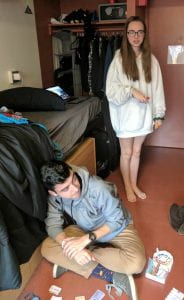My game consisted of an analog version of The Oregon Trail, made on a Game of Life board, with Life pieces and money. I wanted to recreate a famous digital game as a board game; the fact that Oregon Trail was originally a text-based game was also interesting, as a board game seemed like an evolutionary step, between text and computer game, that didn’t exist. As I researched and read articles from the designer who helped make the text game a computer game, I realized how complicated the mechanics were behind the scenes, and I tried to simply them while also making the elements of chance visible.
This is part of my appropriated Game of Life board (in horrible phone-photo quality):

The rules are here.
Iterations:



I playtested first in class. This helped to work out some kinks, such as the options for moving, the too-small food denominations, and the ease of replenishing food through the minigame. (Since my dartboard had not yet come in, we played paper football, which was too easy, especially since you could Hunt and Move each turn.) Also, no party members died, which does not accurately reflect the Oregon Trail game, so I decided to make it more difficult. The guest teacher suggested that there be automatic death from dysentery, which I thought was a good idea so I changed those sickness tiles to death tiles.

I playtested the new game with my friends once my dart board arrived. It worked a lot better, but was still very slow, which led to the fact that you can move twice if you have 2+ oxen. This also fixed a problem we ran into where a player got stuck since they had to keep hunting for food and then immediately paying that food to the bank, leaving no room for them to move forward since they had nothing to trade. I also noticed that there was a lot of leftover money, so I changed the starting money to what it was originally. I also removed the requirement to stop at every fort, because it became redundant and equalized where people were too much. This was a good playtest because they were constantly trying to push boundaries, asking if they could resurrect or eat their dead members, or eat the oxen, which forced me to make more explicit rules.
Statement:
This game came about by thinking of what to appropriate. Originally I wanted to make a game about appropriation, but decided that using actual appropriation would be better-suited to a smaller project. I decided on Oregon Trail because it’s iconic as a computer game, and also because I had recently played it and wondered at how and why things happened, and saw its potential as group game because my roomie and I were playing separately at the same time and updating each other on our progress. I chose the Life board because it fit well with the cars and people, and the new version with pets was perfect for the oxen. I ended up painting over most of the board and covering all the spaces with my Oregon Trail text copied from the 1971 game (the text was shortened to fit and I changed “Indian” from the game to “Native American”). Since the hunting minigame was an important part of bringing the game from text to computer, I wanted that to be skill-based, and decided appropriating darts would work well.
The idea of taking something and using it against its purpose was an aspect of Dada and Fluxus, and I was especially thinking of Duchamp’s readymade Bicycle Wheel, which in combining two objects made them useless. In this case, the Game of Life board was no longer playable as that game, but as a new one (Oregon Trail) that was in a different format than it was created in. The collaborative way my friends and I added and subtracted rules mid-game also seemed to speak to the collaborative, sometimes spontaneous entertainment performed in the Cabaret Voltaire.
